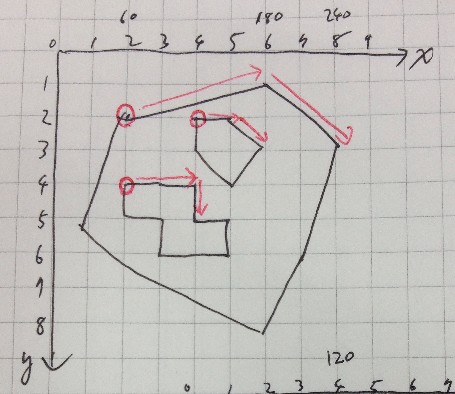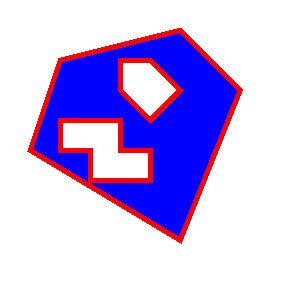Java donut polygon (polygon with holes) (2012-01-16)
Using a class java.awt.geom.Area.
I make this shape.

souce code:
import java.awt.*;
import java.awt.geom.*;
import java.awt.image.*;
import java.io.*;
import javax.imageio.*;
public class DonutPolygon {
public static void main(String[] args) throws Exception {
Polygon out1 = new Polygon(new int[]{60,180,240,180,30}, new int[]{60,30,90,240,150}, 5);
Polygon in1 = new Polygon(new int[]{120,150,180,150,120}, new int[]{60,60,90,120,90}, 5);
Polygon in2 = new Polygon(new int[]{60,120,120,150,150,90,90,60}, new int[]{120,120,150,150,180,180,150,150}, 8);
Area area = new Area();
area.add(new Area(out1));
area.subtract(new Area(in1));
area.subtract(new Area(in2));
// print PathIterator
printPathIterator(area.getPathIterator(new AffineTransform()));
BufferedImage image = new BufferedImage(300, 300, BufferedImage.TYPE_INT_ARGB);
Graphics2D g = image.createGraphics();
g.setPaint(Color.BLUE);
g.fill(area);
g.setStroke(new BasicStroke(5.0f));
g.setPaint(Color.RED);
g.draw(area);
g.dispose();
ImageIO.write(image, "png", new File("donut_polygon.png"));
}
private static void printPathIterator(PathIterator pi) {
switch (pi.getWindingRule()) {
case PathIterator.WIND_EVEN_ODD:
System.out.println("WindingRule: WIND_EVEN_ODD");
break;
case PathIterator.WIND_NON_ZERO:
System.out.println("WindingRule: WIND_NON_ZERO");
break;
}
while (!pi.isDone()) {
double coords[] = new double[6];
int type = pi.currentSegment(coords);
switch (type) {
case PathIterator.SEG_MOVETO:
System.out.print("SEG_MOVETO: ");
break;
case PathIterator.SEG_CLOSE:
System.out.print("SEG_CLOSE: ");
break;
case PathIterator.SEG_LINETO:
System.out.print("SEG_LINETO: ");
break;
case PathIterator.SEG_CUBICTO:
System.out.print("SEG_CUBICTO: ");
break;
case PathIterator.SEG_QUADTO:
System.out.print("SEG_QUADTO: ");
break;
}
System.out.println(
"(" + coords[0] + "," + coords[1] + ") " +
"(" + coords[2] + "," + coords[3] + ") " +
"(" + coords[4] + "," + coords[5] + ")");
pi.next();
}
}
}
This image is output. This is donut polygon.

PathIterator infomation:
WindingRule: WIND_NON_ZERO
SEG_MOVETO: (150.0,60.0) (0.0,0.0) (0.0,0.0)
SEG_LINETO: (180.0,90.0) (0.0,0.0) (0.0,0.0)
SEG_LINETO: (150.0,120.0) (0.0,0.0) (0.0,0.0)
SEG_LINETO: (120.0,90.0) (0.0,0.0) (0.0,0.0)
SEG_LINETO: (120.0,60.0) (0.0,0.0) (0.0,0.0)
SEG_CLOSE: (0.0,0.0) (0.0,0.0) (0.0,0.0)
SEG_MOVETO: (120.0,120.0) (0.0,0.0) (0.0,0.0)
SEG_LINETO: (120.0,150.0) (0.0,0.0) (0.0,0.0)
SEG_LINETO: (150.0,150.0) (0.0,0.0) (0.0,0.0)
SEG_LINETO: (150.0,180.0) (0.0,0.0) (0.0,0.0)
SEG_LINETO: (90.0,180.0) (0.0,0.0) (0.0,0.0)
SEG_LINETO: (90.0,150.0) (0.0,0.0) (0.0,0.0)
SEG_LINETO: (60.0,150.0) (0.0,0.0) (0.0,0.0)
SEG_LINETO: (60.0,120.0) (0.0,0.0) (0.0,0.0)
SEG_CLOSE: (0.0,0.0) (0.0,0.0) (0.0,0.0)
SEG_MOVETO: (180.0,30.0) (0.0,0.0) (0.0,0.0)
SEG_LINETO: (60.0,60.0) (0.0,0.0) (0.0,0.0)
SEG_LINETO: (30.0,150.0) (0.0,0.0) (0.0,0.0)
SEG_LINETO: (180.0,240.0) (0.0,0.0) (0.0,0.0)
SEG_LINETO: (240.0,90.0) (0.0,0.0) (0.0,0.0)
SEG_LINETO: (180.0,30.0) (0.0,0.0) (0.0,0.0)
SEG_CLOSE: (0.0,0.0) (0.0,0.0) (0.0,0.0)
Posted by NI-Lab. (@nilab)
